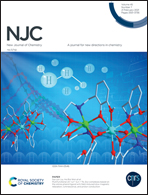Electrochemical performance of the homologous molybdenum(vi) redox-active gel polymer electrolyte system
Abstract
Poly(vinyl alcohol)–phosphoric acid–phosphomolybdic acid hydrate (PVA–H3PO4–PMo12, PPP) and poly(vinyl alcohol)–phosphoric acid–sodium molybdate (PVA–H3PO4–Na2MoO4, PPM) are synthesized to form an asymmetric gel polymer electrolyte (GPE) system PPP|PPM. PPM and PPP GPEs worked on the sides of the positive and negative electrodes respectively to fabricate a carbon paper (CP) supercapacitor. The influence of PMo12-to-PVA and Na2MoO4-to-PVA mass ratios on the ionic conductivity of GPEs is discussed. The maximum ionic conductivity of PPP|PPM can reach 36.43 mS cm−1 which is 5 times that of PVA-H3PO4. Both the Na2MoO4 electrolyte and the PMo12 electrolyte exhibit reversible redox activity and provide excellent pseudo-capacitance to improve the capacitance performance. Accordingly, the asymmetric PPP|PPM GPE has the highest specific capacitance of 170.03 mF cm−2 and an energy density of 236.15 mW h m−2 at 0.5 mA cm−1 when compared with 23.80 mF cm−2 and 32.06 mW h m−2 for the PP GPE. In addition, it shows outstanding cycling stability with an 80% capacitance retention ratio at 0.5 mA cm−2 after 1000 charge per discharge cycles. Density functional theory calculations are used to investigate the interaction between electrolytes and electrodes. The enhancement of the electrochemical performance of the GPE is assigned to the reversible faradaic reaction associated with the redox PMo12 (Mo(V)/Mo(VI)) and Na2MoO4 (Mo(VI)/Mo(V)) in the asymmetric GPE system.



 Please wait while we load your content...
Please wait while we load your content...